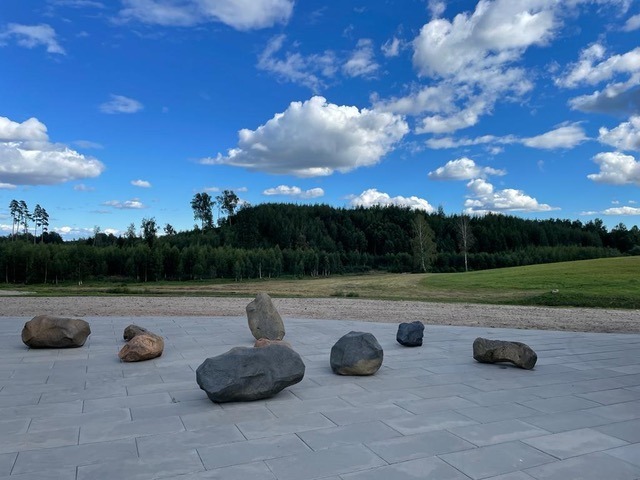
Silence. Sound. Horizon
Arterritory’s nomadic gallery energART* inhabits the nature space of “Dūrmuiža”, owned by Agita and Andris Putāns. September 4–24, 2022
This is a time that, in its own way and at its own speed, brings each of us closer to ourselves. Everything lies within us. The most important thing is to listen – to listen, to hear, and to carefully follow. The only way to truly hear is to go into your inner silence. A space that is free from noise and mental chatter. Nature, art and sound are tools that can help us enter it. This space awakens feelings, emotions and thoughts, and serves as an impulse for a new experience of creation – of opportunity and conviction.
Inner silence is the space in which the artist creates. A space in which to find refuge and strength when chaos and anxiety reign all around. A space that allows us to realise that the horizon has no bounds; it is limited only by our ability to see. As soon as we realise this, our perspective changes.
Set in a picturesque natural landscape, the exhibition Silence. Sound. Horizon offers everyone the opportunity to meet their inner silence through art and sound. As a symbol of strength for getting through autumn, take with you the vibration of this encounter with the field of art that has been created by Hele, Luīze Rukšāne, Pauls Rietums, Estere Betija Grāvere, Dainis Pundurs, and MAREUNROL’S.
The project’s venue is located on the property of Agita and Andris Putāns – “Dūrmuiža”. Dūre was once a knight's manor in Tukums Parish. In 1798 Friedrich Hermann von Grotthuss separated Dūre and Mazdūre from Grenči Manor. It passed from hand to hand until 1839, when it became the property of Julius Baron von Haaren, a retired lieutenant of the Russian Imperial Guard. The last owner of the manor was Freiherr Kurt von Haaren. In 1900 the manor had 79 inhabitants: 44 men and 35 women. The manor had a dairy and bred cattle and pigs. In 1912 the manor covered 728 hectares (of which 663 hectares were farmland), and included the Mazdūre half-manor and the Liepu krogs tavern.
In his will, Baron Kurt von Haaren bequeathed the manor to his nephew Wilhelm Eugen Paul von Haaren, who was a minor living in Germany. In 1939 the manor was nationalised through the agrarian reforms enacted by the Latvian Ministry of Agriculture. At the end of WWII, the manor house was completely destroyed in the violent battles of the Courland Cauldron (today, only the excavated and now-preserved foundations of the manor and some old lime trees serve as proof of the building’s existence), yet its energetic imprint can still be felt in the present day. The silence of the natural space sharpens one’s senses and perception, while the emotional atmosphere recharges creative thought.
In the property’s hillocks and meadows inhabited by animals, insects and birds, art has become another point of interest in a landscape that is in synergy with all that lives there. The scope of the horizon continues in Luīze Rukšāne's exquisitely realistic drawings/miniature paintings; an explosion of summer colours, mixed with the blue of the sky, inhabits Hele's tapestries; the stones of the former manor house, now part of the new buildings, seemingly reflect the meteorites created by Dainis Pundurs; the harmonious order found in the work of Estere Betija Grāvere is a true counterpart to the surrounding landscape; MAREUNROL’S fabric bas-reliefs, right next to the gigantic rolls of hay, become an instrument for inward conversation, a form of artistic communication that spatially connects the facade and its “lining”; and last but not least, the organic fragility and delicateness of Pauls Rietums' objects and pastels become even more apparent in this environment.
The exhibition will be on view at “Dūrmuiža” from September 4 to 24, by appointment only. Please contact energart@arterritory.com to reserve a time.














